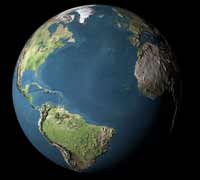Days may have 25 hours in near future due to Earth’s decelerating rotation
Days are gradually growing longer. To the layman this means that in the northern hemisphere days are longer in summer than they are in winter. But geoscientists interpret this phrase as follows: they found that days grow longer not only in spring time.

The reason for that is the Moon, first and foremost. Its gravity creates permanent waves in oceans and in Earth’s depths. Thus our planet seems to waver, the German newspaper Suddeutsche Zeitung wrote.
Earth resembles a rotating figure skater. To slow rotations down, a figure skater stretches his or her arms out. That is why in the far future there will be 25 hours in a day. A British astronomer managed to prove that Earth’s rotation has been slowing down since 700 B.C.
The scientist studied clay plates and other historical writings that contained information about solar and lunar eclipses. He used the information to calculate the Earth’s breaking path.
Also read: Earth's axis displacement to lead to mammoth global changes
When prehistoric proto-animals inhabited Earth 530 million years ago, there were 21 hours in a day. For dinosaurs who lived 100 million years ago days alternated each other every 23 hours.
This can be clearly seen by marly sediments of corals. Corals seem to mark the calendar and annually form new sediments the thickness of which varies depending on the season.
By means of that scientists calculated the timescale between springs. This period has been slowing down throughout history. About 530 million years ago Earth rotated on its axis faster than it does today, but it rotated about the sun at a steady speed. At that time the year had the same amount of hours as it has today, but there were 420 days in it. According to trustworthy sources, throughout the history of mankind Earth’s rotation has been reducing its speed, Richard Stephenson from Durham University, UK, says for the Journal for the History of Astronomy.
Stephenson based his conclusions on descriptions of hundreds of solar and lunar eclipses during the last 2,700 years. Clay plates of pre-Christian Babylon substantiate the slowdown in the Earth’s rotation best of all, Stephenson wrote. Babylonian scientists used cuneiform characters to record the exact place and time of celestial events.
Moreover, Stephenson studied documents of the Chinese and European origin. Once in about 300 years people can observe the total solar eclipse from anywhere. When the Moon takes place between the Sun and the Earth, total darkness occurs for several minutes.
As often as not, they noted the exact day and time of the beginning and the end of a solar eclipse. This information was enough for the astronomer to determine the exact position of the Sun as it was thousands of years ago. Tables for re-calculating dates of the Babylonian calendar came in handy.
Astronomers used the data about the position of the Sun in historical writings to restore the picture of the planet’s slowdown.
Since the trajectory of the Earth’s rotation about the Sun is not connected with the Earth’s rotation on its axis, astronomers calculated the independent timescale – the so-called Terrestrial Time (TT). Slowdown in the Earth’s rotation is seen if we compare the Terrestrial Time with the Universal Time (UT).
UT is the general time based on the rotation of the Earth and is determined by the Sun position with regard to Greenwich Mean Time (GMT) (Greenwich is a British city). It is necessary to set this time backward, for every several years between the end of one year and the beginning of the other there is one spare second.
Richard Stephenson used historic writings to determine the correlation between the two times. The difference between UT and TT depends on how long ago an eclipse took place. Thus, over a millennium a day grows longer by two thousandths of a second. The measurements made by satellites prove the slowdown. It turns out that in the prime of Babel a day was shorter by four hundredths of a second.
Nevertheless, Stephenson managed to determine this tiny abnormality due to the mistake in UT. Since 700 BC about a million days have passed that were shorter than today, thus we would have to set the clock by seven hours.
The last years made an exception. During this time the day almost did not grow longer; the Earth rotated almost at a steady speed. The shift of masses in the earth might speed up the Earth’s rotation and make up for the slowdown caused by the Moon. The terrible earthquake in Southern Asia and the tsunami afterwards quickened the Earth’s rotation in late 2004, which shortened the day by about eight millionths of a second.
According to the International Earth Rotation and Reference Systems Service (IERS), July 13 2003 was the shortest day within the last 100 years. This day was shorter than an average 24-hour day by 1.5 thousandths of a second.
Translated by Julia Bulygina
Pravda.ru
Subscribe to Pravda.Ru Telegram channel, Facebook, RSS!




